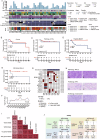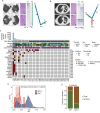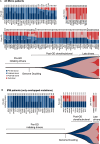Optimizing the NGS-based discrimination of multiple lung cancers from the perspective of evolution
- PMID: 39809905
- PMCID: PMC11733135
- DOI: 10.1038/s41698-024-00786-5
Optimizing the NGS-based discrimination of multiple lung cancers from the perspective of evolution
Abstract
Next-generation sequencing (NGS) offers a promising approach for differentiating multiple primary lung cancers (MPLC) from intrapulmonary metastasis (IPM), though panel selection and clonal interpretation remain challenging. Whole-exome sequencing (WES) data from 80 lung cancer samples were utilized to simulate MPLC and IPM, with various sequenced panels constructed through gene subsampling. Two clonal interpretation approaches primarily applied in clinical practice, MoleA (based on shared mutation comparison) and MoleB (based on probability calculation), were subsequently evaluated. ROC analysis highlighted MoleB's superior performance, especially with the NCCNplus panel (AUC = 0.950 ± 0.002) and pancancer MoleA (AUC = 0.792 ± 0.004). In two independent cohorts (WES cohort, N = 42 and non-WES cohort, N = 94), NGS-based methodologies effectively stratified disease-free survival, with NCCNplus MoleB further predicting prognosis. Phylogenetic analysis further revealed evolutionary distinctions between MPLC and IPM, establishing an optimized NGS-based framework for differentiating multiple lung cancers.
© 2025. The Author(s).
Conflict of interest statement
Competing interests: The authors declare no competing interests.
Figures







Similar articles
-
Development and validation of machine learning models based on molecular features for estimating the probability of multiple primary lung carcinoma versus intrapulmonary metastasis in patients presenting multiple non-small cell lung cancers.Transl Lung Cancer Res. 2025 Apr 30;14(4):1118-1137. doi: 10.21037/tlcr-24-875. Epub 2025 Apr 25. Transl Lung Cancer Res. 2025. PMID: 40386724 Free PMC article.
-
Using molecular characteristics to distinguish multiple primary lung cancers and intrapulmonary metastases.PeerJ. 2024 Jan 31;12:e16808. doi: 10.7717/peerj.16808. eCollection 2024. PeerJ. 2024. PMID: 38313018 Free PMC article.
-
Establishment of Criteria for Molecular Differential Diagnosis of MPLC and IPM.Front Oncol. 2021 Jan 21;10:614430. doi: 10.3389/fonc.2020.614430. eCollection 2020. Front Oncol. 2021. Retraction in: Front Oncol. 2024 Mar 20;14:1399853. doi: 10.3389/fonc.2024.1399853. PMID: 33552986 Free PMC article. Retracted.
-
Next-Generation Sequencing vs. Clinical-Pathological Assessment in Diagnosis of Multiple Lung Cancers: A Systematic Review and Meta-Analysis.Thorac Cancer. 2025 Mar;16(6):e70039. doi: 10.1111/1759-7714.70039. Thorac Cancer. 2025. PMID: 40118796 Free PMC article.
-
Multiple primary lung cancer: Updates of clinical management and genomic features.Front Oncol. 2023 Feb 22;13:1034752. doi: 10.3389/fonc.2023.1034752. eCollection 2023. Front Oncol. 2023. PMID: 36910635 Free PMC article. Review.
References
-
- Siegel, R. L., Miller, K. D., Fuchs, H. E. & Jemal, A. Cancer statistics, 2022. CA Cancer J. Clin.72, 7–33 (2022). - PubMed
-
- Cheng, H., Lei, B. F., Peng, P. J., Lin, Y. J. & Wang, X. J. Histologic lung cancer subtype differentiates synchronous multiple primary lung adenocarcinomas from intrapulmonary metastases. J. Surg. Res.211, 215–222 (2017). - PubMed
LinkOut - more resources
Full Text Sources

